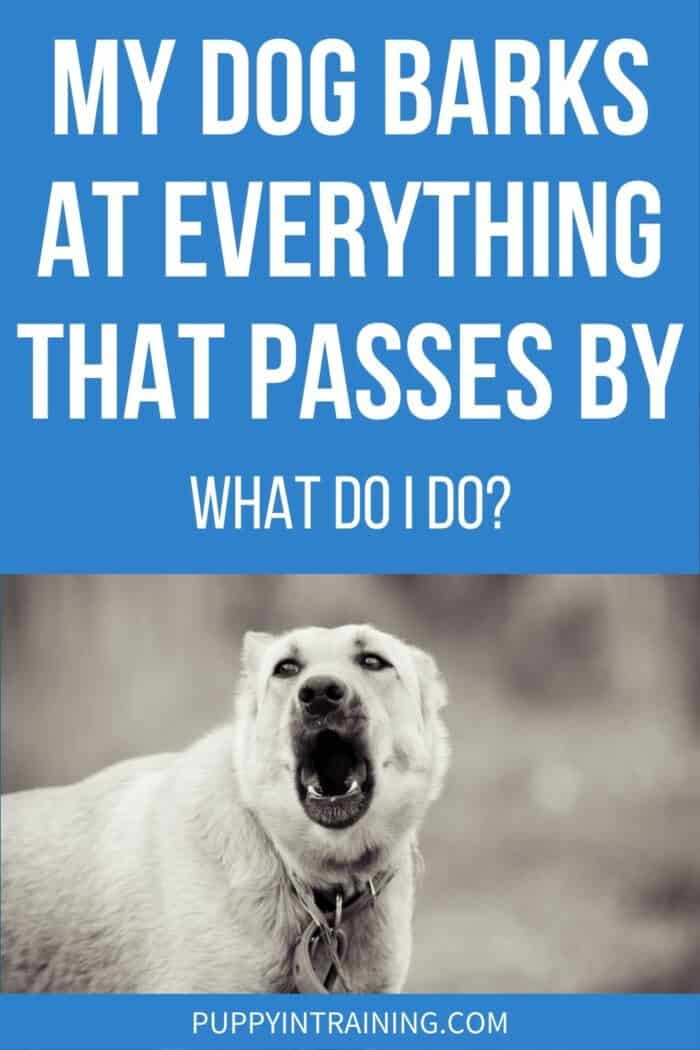This post may contain affiliate links. We may earn money or products from the companies mentioned in this post.
Your dog seems to bark at everything that passes by. It’s not only annoying but can even be dangerous sometimes.
Excessive barking can disturb neighbors and even you, despite your love for your dog. It can also lead to fines from a township or landlord–or even eviction.
Of course, most dogs bark occasionally. They shouldn’t be robots that don’t respond to their environment.
But excessive barking is another matter.

You want to stop the constant noise. But how do you stop a dog from barking at things that pass by?
As a dog trainer, I’ve worked with numerous owners and their dogs to stop excessive barking.
I’ve had many dogs who tended to bark more than others. I understand how how frustrating it can be to have a “barky” dog.
Some breeds–like my shelties and Lhasa apsos–naturally bark more than others because of the purpose that they were bred for.
Shelties were bred to herd. In addition to circling the animals they herd, they bark in a high-pitched manner.
And Lhasas were bred to be sentinels in Tibet who barked to call the larger watch dogs.
Despite their natural tendency to bark, I’ve successfully trained my dogs not to constantly bark at everything they normally would.
In this article, I’ll answer a common question from readers: “My dog barks at everything that passes by, what do I do?” I’ll discuss many reasons why dogs bark. And I’ll set forth ways to limit excessive barking as well as improper ways people attempt to stop a dog from barking.
Article Summary
- Dogs bark as a form of communication. Having a dog means that he’ll probably bark sometimes.
- But excessive barking can be more than just an annoyance. Neighbors, landlords, and townships may even take action against you for your dog’s excessive barking.
- A dog barks excessively for many reasons. Once you discover the trigger that sets your dog off, you can appropriately deal with it and rectify the situation.
Why Dogs Bark
Dogs bark as a form of communication. There is various information that they’re attempting to convey by doing so. And there are many reasons why they bark.
Territorial or Protective Barking
Dogs who bark for these reasons do so because they see strangers or other animals (or even a vehicle or bike) that approach their territory as a threat.
Their territory can include your home and surrounding property. It can also include the area around your vehicle when he’s in it.
And some dogs will bark protectively to protect you or even surroundings they see as theirs while on your regular walk. If the perceived threat is too close, the dog will excitedly bark.
The vocalization is usually louder and faster the closer the threat becomes.
The body language of a dog engaging in territorial or protective barking is usually leaning forward or even lunging. Their ears (depending on the natural ear set) are forward.
If the tail wags, it’s a stiff wag, not the loose wag of a happy, playful dog. And their eye has a hard stare.
If the object of their barking moves away, as it normally does naturally, the dog will stop barking when he feels that it’s safe to do so.
The behavior of these dogs who engage in barking.are reinforced in their behavior because the object or living being that they’re barking at either naturally goes away or does so out of caution.
Alarm or Fearful Barking
Dogs sometimes bark when something that they see or hear startles them. And some noises or something they see such as a person, another dog, or even a vehicle such as truck or motorcycle passes by.
The body language of a fearful dog can include the ears pulled back, tail tucked underneath them, and trembling.
Like protective or territorial dogs, the behavior of these dogs who engage in barking.are reinforced in their behavior because the object or living being that they’re barking at either naturally goes away or does so out of caution.
Barking Because of Boredom, Loneliness, or Sadness
Some dogs will bark because they’re unhappy, bored, or lonely. This usually occurs when a dog is left alone for long periods or left with nothing to occupy him.
Barking Because of Genetics
As I mentioned above, some dogs tend to bark more than others because of what they were bred to do.
For example, some herding breeds like shelties and Australian shepherds naturally bark because of their purpose.
Some breeds bred to guard or warn of danger like Doberman pinschers, German shepherds, or Rottweilers May bark more than others.
Some terriers bark when chasing their prey, such as Scotties, cairn terriers, and Westies. And some hounds bay when hunting.
Barking When Greeting or in Play
Some dogs bark when greeting a person or animal friend like a dog or cat. And others do so when about to play or during play.
This is often accompanied by a “yippy,” high-pitched bark. And the dog’s body language is loose, with tail wags and happy jumping.
Attention-Seeking Barking
Dogs also bark when they want something. This can be a treat, to play, to go outside, or even for your attention.
One of my dogs, an Aussie mix named Millie, would bark excessively when she wanted to play, potty, or get my attention.
I worked through the issue so that she barks (one bark) when she has to potty. If she has to go immediately, she may bark a few times, which is fine with me.
It beats a cacophony of barking that used to occur. And, after all, I don’t expect my dogs not to bark at all. They’re living beings with feelings and needs.
I just want to stop excessive barking.
Barking Because of Separation Anxiety or Compulsive Barking
Some dogs who have separation anxiety bark when left alone. The barking is usually excessive and may even go on for hours.
It’s usually accompanied by some other behaviors, depending how severe the separation anxiety is. It may be associated with behavior seeking to escape when left alone, such as digging at windows or door frames.
Some dogs who have separation anxiety inappropriately defecate or urinate because of stress and anxiety. And some pace or circle and may whine too.
Helping a dog with separation anxiety often requires professional help from a behaviorist or positive reinforcement trainer who has experience with the condition.
Some dogs may bark because of a compulsion. It’s similar to obsessive-compulsion behavior in people.
Dogs with this condition often just enjoy the sound of their own voice. It’s fun for them to bark. And the more that they bark, the more reinforcing it is to them.
Medical Problems
Some dogs bark because of medical issues.
Pain from an injury or wound such as a bee sting or arthritis can cause a dog to bark excessively. Older pets may suffer from a form of senility which can cause such barking.
My Dog Barks At Everything That Passes By, What Do I Do?
There are many ways you can try to prevent or deal with excessive barking. How you should approach the problem depends on why the dog’s engaging in that behavior.
You may need a combination of methods to conquer the excessive barking. Of course, a dog may bark sometimes. It’s just the extreme nature of the noise that should be curtailed.
Try to stop the excessive barking behavior as soon as you can. The longer it goes on, the longer it may take to make it just normal barking. Also, excessive barking gives dogs an adrenaline rush that rewards his barking.
Of course it takes a lot of patience and consistency–and time–to teach a dog not to bark excessively.
Physical Exercise
A dog who has too much energy is likely to engage in many undesirable behaviors. These include jumping on people, chewing inappropriate items, and excessive barking.
So make sure that your dog has a sufficient amount of physical exercise for his age, breed, and health. Although it’s usually not the only thing that you have to do to prevent excessive barking, it’s usually an important part of the puzzle.
Walks and play can really improve the behavior of some dogs to take the edge off excessive energy.
Mental Exercise
Giving a dog mental stimulation is as important as providing physical exercise.
Forms of canine enrichment help all dogs–especially those who are bored.
These may include activity toys, treat-dispensing toys, and lick mats. You can even make up your own enrichment activities.
If a dog isn’t destructive, you can hide toys or treats and teach him to find them.
You can make your own puzzle toy with a muffin pan by putting a treat in each divider, covering each one with an appropriately-sized ball like a tennis ball made for dogs.
The sky’s the limit to engage your dog in mind-expanding activities.
Manage the Environment
If a dog is barking because he sees something out of a window, block the view by curtains, shades, or blinds–whatever cover is safe for the dog.
Or if a sound is bothering your dog, close the window or otherwise block the sound by putting on the TV or using a white-noise machine.
Or put your dog in another part of your house where he’s not subjected to his visual or noise triggers.
If your dog is overly stimulated and barks excessively at certain objects like trucks or living creatures, try not to pass by areas that have them or other similar triggers until you’ve counter-conditioned and desensitized your dog to them.
Another way to manage the environment is to not leave your dog in the yard alone if he barks excessively in that setting.
Have Someone Take Care of Your Dog When You’re Away
If your dog suffers from separation anxiety, needs more exercise, or is bored, you can have someone stay with your dog while you work through the issue.
This may be for the entire time or just to take him out for a play session or walk.
Sometimes putting your dog in a doggie daycare can help dogs with separation anxiety. It can also alleviate boredom and exercise the dog’s body and mind.
Do Special Activities With Your Dog
Of course, all dogs should have some type of obedience training. It not only communicates what behaviors we desire but it also furthers our bond with our dogs.
You can do basic commands like pay attention, come, sit, down, stay, and leave it. You can even get fancier and teach your prodigy tricks like spin and dance.
You may also engage in other activities like agility, rally, and canine nosework.
Participating in the above activities will help tire your dog out in addition to relieving boredom.
Teach Incompatible Behaviors
Teach your dog to go to a mat or dog bed and sit/stay and down/stay when there.
This helps a dog not to be over-stimulated when he hears something like a knock at the door or doorbell. This shows dogs how to have impulse control.
In teaching this, you first teach the dog to go to the mat by luring him onto it. If he doesn’t know sit/stay or down/stay, teach them separately.
If he knows them, use them after teaching him to go to the mat as a separate command. Work at a lower level of stimulation after he can down/stay or sit/stay on the mat or bed for at least a few minutes.
Start with you or a helper just touching the doorknob. Once he can go to the mat or bed and stay there without barking, add higher levels of stimulation.
Turn the doorknob, open the door, knock at the inside of the door, have someone knock on the door from outside, have someone come in from outside, have someone ring the doorbell, then, finally, have the person come in after ringing the doorbell.
Of course, your dog should be successful at the prior level before moving on to a higher level of stimulation.
You can also teach him other incompatible behaviors like a sit/down/sit, a trick, targeting, or other behaviors instead of barking. The sky’s the limit!
Another thing you can do when a dog becomes over-stimulated by a sight or noise is throwing down about five kibble or very small treats, scattered.
Give the cue “find it” immediately prior to tossing the treats down. You have to do this BEFORE the dog barks. It redirects him to something else and rewards him for being quiet.
If a dog is over-stimulated by visitors, you can throw about five or so treats scattered before the dog barks, telling him to “find it.”
Alternatively, you can teach your dog to play tug when someone comes in the door. Of course, your dog should know the following commands to do this: take it, tug, and give.
These exercises mean that great things happen when someone comes in the door. They should also prevent excessive barking. You can even add a second command such as sit/stay or go to a bed/mat.
Of course, with any work with someone coming in a door, you don’t want to do these exercises if your dog is aggressive in that setting. Instead, get professional help from a behaviorist.
Desensitize the Dog to the Triggering Stimulus
Do some set-ups with the triggering stimulus. This needs to be done at a distance at which your dog isn’t triggered (that is, doesn’t bark or otherwise react such as by spinning or lunging).
For example, have a non-reactive dog that your dog would bark at if too close at a distance where your dog doesn’t react.
Pro-Trainer Tip: Always have very high-value treats ready. These are usually meat, cheese, or fish-type treats. Vary the type of treats so that your dog doesn’t become bored. And treats should be cut or broken into the size of a pea.
Give him a stream of high-value treats when the dog is in view and your dog is calm and nonreactive. This may be 20 feet or it may be 50 feet. It all depends on your individual dog’s reaction.
The treats stop when the other dog goes out of sight. Or you could take your dog out of sight. Reward only when the other dog is in view and your dog isn’t reactive.
Just do this for a short time like a minute per time period, with up to three repetitions at any session. You may start at just 20 seconds where your dog views the other dog.
The point is you don’t want your dog to become stressed and reactive.
Do the same type of exercise with other triggers that prompt your dog to bark. Over time, depending on your dog’s reaction, you can get closer in small increments to the triggering stimulus.
Then do the same desensitization exercise. This may take weeks or months, depending on your dog’s reaction.
Don’t rush the process. If at any time your dog has a set-back, go back to a step at which he was successful. Then, move ahead again.
Teach a Quiet Command
Another way to successfully work with excessive barking is to teach your dog to be quiet on your cue. One way to teach this is to teach a speak command when he barks.
Then, the split second that he’s quiet, give him a treat and praise him (Yes! Good Quiet). Eventually, extend the time that he’s quiet before rewarding him.
This method works for some dogs, but not for others. If your dog barks again just to get the treat for being quiet, I would use a different method.
This method worked well for my shelties. I taught them a “speak” cue, then a “quiet” one. When I say “quiet” now, I give verbal praise but give only random treats as reinforcement because they are reliable in their behavior.
Ignore the Barking
This can be effective for attention-seekers. You can turn away or even get up and leave the area for a short time such as 30 seconds.
This means no attention at all. Don’t even say anything when you depart or look at him. Then, return. Do this three times.
If it doesn’t work, apply other methods before the dog barks, such as providing more physical and mental exercise.
Socialize Your Dog
If he’s barking because something is new and exciting, get him used to new environments that he’ll need to be in.
Make sure that he’s well-exercised first and use some incompatible behaviors and desensitization as discussed above.
Get Professional Behavioral Help
If you’ve tried to work through the issue of your dog’s reactivity unsuccessfully, don’t despair.
Get appropriate help from a canine behaviorist or a positive reinforcement dog trainer familiar and successful with the reason why your dog barks excessively.
Get Veterinary Help
If there’s any doubt that your dog suffers from a physical condition–or other reasons he barks don’t apply–get veterinary help.
What NOT To Do: Don’t Try This at Home
Positive training methods should be used when dealing with excessive barking.
Yelling at a dog to stop barking isn’t effective. In fact, the dog may think that you’re joining in!
Using spray bottles with water or shake cans that rattle when shaken also aren’t effective.
In fact, they may even make some dogs get more reactive. And a shake can can make a sound-sensitive dog more fearful of sudden sounds.
Of course, don’t use physical corrections such as hitting or jerking the dog’s leash. In addition to being inhumane, they aren’t effective in the long-run and can even lead to unwanted behaviors such as aggression.
Don’t use bark collars. They don’t deal with the reason why the dog’s barking. And they don’t teach the dog the correct behavior you desire instead of the barking.
A shock collar is inhumane and raises a dog’s stress level. And they may even lead to many unwanted behaviors, such as aggression.
Even collars that spray citronella or a similar substance when a dog barks often aren’t effective. They also don’t teach the alternate behavior that you desire.
De-barking is a controversial subject. Even when done correctly by a veterinarian, the dog can still make a muffled bark sound.
More importantly, it doesn’t reduce the dog’s stress level or deal correctly with the root cause of why he’s barking excessively.
There are better, more humane options such as those discussed above.
FAQs
Why does my dog bark at nothing?
Dogs bark for many reasons, such as noises, people, other dogs, or other stressors or exciting events or creatures. Discovering what your dog’s triggers are will help you determine how to deal with the excessive barking.
How do I stop my dog who constantly barks from vocalizing?
Most dogs bark occasionally. When a dog barks excessively, you need to discover his triggers. They may be a noise, a sight, or the presence of a person or dog, for example. There are many steps you can take to help him bark appropriately. This includes physical and mental exercise and managing his environment.
Should I use a shock collar to stop my dog from barking?
No! This is inhumane and may even create new problems, such as aggression. There are better, humane, more effective ways to stop your dog from barking excessively.
Final Thoughts
Dogs bark as a form of communication. They bark excessively for many reasons.
In order to appropriately deal with it, it’s important to discover its cause.
There are many different ways to work through the issue, depending on why you pup’s barking.
Have patience (and a sense of humor sometimes) and be consistent. It will pay off in the long run. And get appropriate help if you need it.
Save To Pinterest

Top Picks For Our Puppies
- BEST PUPPY TOY
We Like: Snuggle Puppy w/ Heart Beat & Heat Pack – Perfect for new puppies. We get all of our Service Dog pups a Snuggle Puppy. - BEST DOG CHEW
We Like: Best Bully Sticks – All of our puppies love to bite, nip, and chew. We love using Bully Sticks to help divert these unwanted behaviors. - BEST DOG TREATS
We Like: Wellness Soft Puppy Bites – One of our favorite treats for training our service dog puppies. - BEST FRESH DOG FOOD
We Like: The Farmer’s Dog – A couple months ago we started feeding Raven fresh dog food and she loves it! Get 50% off your first order of The Farmer’s Dog.
Check out more of our favorites on our New Puppy Checklist.


